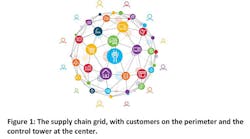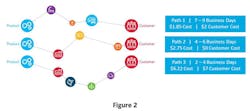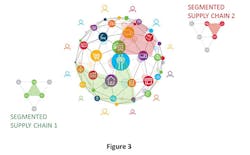Don't Let Omni-Channel Pressures Force You Off the Supply Chain Grid
Seamlessly managing business in today’s ever-changing omni-channel environment is a lot like competing in the Super Bowl: It requires a superior level of skill, agility and collaboration to take home the championship ring. Coaches must devise a strategy and reach consensus about their offensive and defensive lines before they finalize the game plan. Yet, once the players are on the field, any number of things can happen—players get injured, the ball gets intercepted, etc.—to disrupt a team’s plan. The team that can react more quickly to these disruptions, and then execute a newly revised plan to score, is the one that wins.
The same is true in business today. How quickly a company is able to see and react dynamically to market trends, disruption, or change in consumer demand is dependent on the agility of its supply chain and the collaborative relationships it has developed with its supply chain partners. Just as a football is rarely carried in a straight, uninterrupted path toward the goal line, getting a product from one end of the supply chain into the customer’s hands requires significant coordination, adaptation and collaboration between all players of the extended supply chain.
Yet, in reality, often little to no collaboration occurs between retailers, manufacturers and their partners because of differing or conflicting business objectives. We rarely see suppliers, manufacturers, third-party logistics (3PL) providers, warehouses, and retailers operate in unison, and the evolution of today’s connected consumer has only amplified this problem.
Consumers’ expectations are higher than ever now that smart technologies have become an intrinsic part of the shopping experience. Increasingly connected via social media, consumers are more informed and influenced by their peers than ever before. These consumers expect a personalized shopping experience—from initial promotion to post-purchase communication—that’s tailored according to how and when they like to shop. They are also willing to pay more for products and services they value, and they expect these preferences to be anticipated and met.
As a result, succeeding in this new consumer-driven environment is not easy. Increased complexity in the marketplace, data overload, fluctuating demand, trust issues and competitive threats are just a few of the challenges retailers, manufacturers and distributors are facing.
The Impact of Omni-channel in Manufacturing
Fearful of being left behind, many companies are embarking on a “me-too” omni-channel game plan, rushing to offer consumers more personalized products and services. The problem, however, is that few businesses are earning a return on these investments. In fact, according to a recent study conducted for JDA Software by PwC, only 16% of companies can fulfill omni-channel demand profitably today.
In a rat-race to address consumers’ ever-changing expectations, companies are paying a high price to sustain or grow their market share. As businesses sell and deliver products across multiple channels, it’s the high cost of fulfilling orders that is eroding margins. Plus, 67% of companies in the study report that their fulfillment costs are growing, not shrinking, as they increase their focus on selling across channels.
One of the reasons behind this increase is the complexity and high costs associated with managing a fulfillment network that is essentially driven by the end consumer. Smaller order quantities (e.g., eaches or cases), more order variants (e.g., a zillion yogurt flavors) and temperamental consumers who now have access to many different shopping channels are all factors influencing the complexity of the supply chain and the new level of coordination required of all supply chain players. According to the study, businesses report their highest costs associated with omni-channel selling are related to handling returns, shipping directly to customers and shipping to the store for customer pick-ups.
It’s no surprise, then, that the need for multi-channel management has created a plethora of planning and distribution challenges not just for retailers, but for manufacturers, wholesale distributors and 3PLs. In the face of increasing competition and rising demand volatility, companies often make ambitious price/product/service offers in order to win the sale—without considering the true cost of fulfilling those offers.
Manufacturers and their trading partners need to work together as collaborative partners to achieve the ideal balance between too much product and not enough. By tightly connecting the planning and execution processes to what is actually happening with demand, inventory visibility is increased and products can more effectively flow through a synchronized supply chain.
To achieve this level of seamless supply chain planning and execution, companies must build a new type of supply chain—the supply chain grid—that will enable them to thrive in an omni-channel environment.
Introducing the Supply Chain Grid
In today’s omni-channel environment, companies can no longer operate a linear supply chain and hope to win the game. Instead, industry-leading companies are taking supply chain planning and execution to a new level by embracing the concept of the supply chain grid. The supply chain grid is a multi-dimensional network of nodes (suppliers, warehouses, distributors, carriers, etc.) that are interconnected and continuously monitored by a core control tower with one common objective: to efficiently and profitably meet the dynamic nature of consumer demand (see Figure 1).
One of the defining attributes of the supply chain grid is the interconnectedness of all of the nodes, which enable enhanced levels of collaboration and provide companies with critical, alternate pathways when the inevitable supply chain hiccup occurs. The spherical shape enables optimal decision-making among supply chain players, as collaboration between multiple connection points delivers greater insight into consumer behavior. As a result, supply chain players can select the most effective supply chain path, based on available resources, to profitably meet their customers’ needs. To truly benefit from the supply chain grid, all of the connection points must be strong.
By adopting this new supply chain strategy, companies can take their supply chain game to a new level, embracing new approaches for collaboration, customer-centricity and segmentation:
Collaboration
The design of the supply chain grid supports continuous multi-directional collaborative communication. Yet, despite the benefits of this approach, few companies have embarked on this level of collaboration with their trading partners. Instead, in response to omni-channel pressures, companies are making fulfillment decisions without a holistic view of inventory, labor and transportation availability and costs, often sacrificing long-term profitability in order to service short-term customer satisfaction.
For example, if there isn’t enough labor at the distribution center to unload inbound shipments for a planned promotion, companies have to choose between costly overtime and lost sales. If order management and transportation management systems are not linked, carriers may be frequently shipping less-than-full truckloads to the same location. If the planning process lacks visibility into upstream and downstream order and inventory information, the supply chain cannot respond quickly when the unexpected occurs—leaving plans both out-of-date and un-executable. This leads to overstocks, out-of-stocks and, ultimately most impactful to the business, dissatisfied customers. Embracing a new level of collaboration, enabled by the supply chain grid, will help solve this.
It’s no longer enough to share transactional data with trading partners. Retailers and manufacturers must be willing to engage in higher levels of collaboration—such as shared visibility into forecasts and demand intelligence or data transmission via the Internet of Things—if they want to achieve game-changing collaborative performance.
The information that is shared across each of these nodes will provide trading partners with tremendous opportunities for collaboration and visibility into true demand. This includes demand that is known, as well as demand that is yet-to-be-known.
Customer-centricity
Increased collaboration can lead to leaner supply chain organizations and the formation of better supply chain plans. Yet, seasoned supply chain practitioners know that not everything goes according to plan. An unexpected surge in demand, a shipment held up at port, unexpected factory shutdowns, or a last-minute order from a priority customer—all of these scenarios represent supply chain disruptions or bottlenecks that can threaten a company’s profitability.
In order to be agile and responsive to these types of changes, and ensure that customers’ needs are being met in a profitable manner, companies need to adapt their operations to mirror the supply chain grid.
At the core of the supply chain grid is a control tower, designed to help companies monitor their operations and determine which alternate, profitable course of action to take when disruptions or bottlenecks occur. A control tower ensures customer-centricity by enabling companies to proactively plan for potential disruptions or bottlenecks by predetermining the best course of action based on cost/benefit analysis. Plan adjustments can also be predetermined based on evaluations of past consumer behavior.
By executing on the most profitable, expedient course of action, companies can be sure they’re continuing to meet their customers’ needs, without sacrificing margins.
Segmentation
Finally, the market has embraced and recognized the need for segmentation. Since not all customers are the same, there’s always a clear business need to provide differentiated service levels, and that requires companies to structure their supply chains appropriately. Instead of adopting a one-size-fits-all supply chain strategy, companies must segment their supply chain operations to balance the cost to serve with the value of each customer segment.
The supply chain grid provides companies with the dynamic foundation they need to easily execute their segmentation strategies. For example, in Figure 2, there are three different supply chain paths (each of which involve different nodes, time and cost considerations) that a company could choose when delivering a product to a customer.
In each instance, the company can select the path that works best based on how important that particular customer segment is to their business. For instance, priority customers might get the option to receive products via the second or third path, while less valuable customers might only be given the option of the first path.
Because the supply chain grid is not static, neither is the data associated with each path. The cost to serve an order could be different every time—even if that order is for the same product, from the same region and for the same customer. The benefit of the intelligent and adaptable supply chain grid is that it serves up the most profitable routes/decisions based on the latest collaborative intelligence.
By leveraging the supply chain grid concept, a company can set up all of these segmented paths so that they can co-exist—and thrive—together (see Figure 3).
Winning the Game
Executing the same supply chain strategy across your organization won’t win you a place in the Pro Football Hall of Fame. However, if you can enable interconnectivity between your planning and execution processes across all nodes of your supply chain, you’ll have greater flexibility to efficiently and profitably meet consumers’ ever-changing needs, every time.
As a result of this increased information flow and collaboration via the supply chain grid, relevant decisions can be based on current and future reality, and actual trends driven by end-consumer demand. The end result: a responsive, adaptable and synchronized supply chain organization that can quickly react to a disruption, and execute a new plan to score and win the game.
Doug Kimball is product marketing director and Srini Muthusrinivasan is industry strategies director, manufacturing with JDA Software, a provider of supply chain management solutions.







